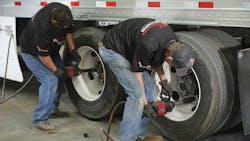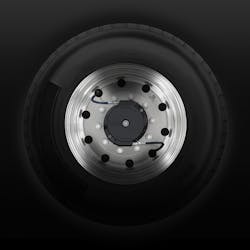This is Part II of our coverage on low rolling resistance tires. To read Part I, click here.
In the updated North American Council for Freight Efficiency (NACFE) Confidence Report on low rolling resistance (LRR) tires, the organization noted the EPA SmartWay-verified tire list grew 37 times larger over the past decade, inflating from eight tire offerings in 2010 to more than 300 as of 2020. They all provide at least some incremental improvement, but how does a fleet know which is going to offer the best total cost of ownership (TCO)?
The quickest, easiest way is through a rolling resistance calculator offered by tire manufacturers, including Goodyear Tire and Rubber, Michelin, and Yokohama Tire. These do the math for fleets after details such as current tires versus potential replacement, number of trucks, and current fuel costs are plugged in. Yokohama’s Fuel Savings Calculator even factors in average tire inflation levels, average tire load, and average fleet miles per gallon. It also calculates current rolling resistance, savings per truck, and carbon footprint reduction.
These are great tools to get a start on optimizing tire TCO, but true efficiency means going beyond plugging in a few numbers.
“Tire rolling resistance can play a large part in fuel efficiency,” said Helmut Keller, Continental’s head of brand and product management for commercial vehicle tires in the Americas region. “However, driver behavior, routing, proper tire pressure management, and other factors also heavily influence a vehicle’s fuel economy. To achieve maximum fuel efficiency, a fleet must take a holistic approach.”
This includes looking at the duty cycle. For instance, Continental’s Conti Hybrid tires were found to offer 6.28% better fuel economy versus two competitors in regional hauls and save up to $4,000 per truck per year (assuming average diesel costs of $3.89/gallon, 5.91 fleet mpg, and 105,000 miles traveled). They provided a 2.11% uptick for long haul, saving $1,400 per truck per year. The test was run by PIT Group of FP Innovations. As mentioned in Part I, Michelin’s X-Line was recently improved with the X One Line Energy T2 trailer tire. With so many brands and so much continuous improvement, relying on one manufacturer’s data might not be the best formula for finding the best fuel-efficient tire for a particular fleet.
“The truth is that they’re all salesmen,” asserted Bear, who said using a calculator can get a fleet in the right ballpark but should not end there. “If the fleet really wants to know, they have to hire someone to figure it out.”
Putting tires to the test
Daryl Bear, lead engineer and COO of MVT Solutions, is the person some fleets have turned to “to figure it out.” The former Indy car engineer backs up his findings with data and proprietary data carried over from the racing industry.
The main goal of MVT Solutions is to save fuel by any means necessary and often in surprising ways. For MVT’s fleet, the subsidiary testing company found changing the mud flaps would save $300,000 across the fleet.
"Tires are a major contributor to fuel consumption, which means they are a great way to save fuel, and that's true whether a fleet is long-haul, regional or urban duty cycle," he said.
To find out just how much fuel can be saved, Bear said his team can factor in different weights, speeds, and fleet differences to mitigate the guesswork and help fleets make more informed decisions based on the numbers. Often, there still can be some guesswork.
Phil Mosier, manager of commercial tire development for Cooper Tire & Rubber, said the life of the Cooper PRO Series tire can range from 180,000 to 400,000 miles. Trucks that make frequent stops wear faster, as do those with higher torque engines.
“The thing about numbers is they don’t lie, but they can fool you,” Bear cautioned.
MVT Solutions seeks to provide transparency and truly solve for real-life fuel efficiency, a tall order for fleet managers tasked with so many other responsibilities.
“I’ve never seen a business that’s as complicated as running a trucking company,” Bear said. “They don’t have time to work on efficiency; it always gets put on the back burner.”
To actually run a statistically valid test by themselves, he said a fleet would need 100 trucks as the sample size. And they would need to factor in variables such as tire temperature, tire pressure, and how results could skew from one driver to the next.
“If measuring fuel savings was easy, then every fleet out there would have the best fuel economy you could get,” Bear said. “But it’s just not easy. There are too many factors and too many things to try and monitor.”
Ralph’s Foods found that out the hard way several years ago when MVT Solutions, formerly InnoMetric MPG, performed tests.
“Getting reliable answers on fuel economy is very challenging, and we evaluate products thoroughly,” recalled Greg Peterson, senior manager of fleet services at Ralph’s. “A few years ago, our company did an extensive in-service test that included 30-plus trucks and 12-plus months of tracking fuel and maintenance. That took a lot of time and manpower with disputable results. In two days, InnoMetric performed similar tests with results that made total sense.”
Bear said the tests he ran in three days with three different tire brands matched what Ralph’s took a year to find. Bear pondered that it can be quite costly to wait a year to find 5% in fuel savings. A fleet can check how tread depth fares between LRR tire brands fairly easily. A fleet just runs one tire a certain number of miles on a truck, measuring the tread depth, and then swaps out to another brand (when uptime considerations allow it) to see which tire tread wore more over the same period. Sometimes the tire manufacturers make it easy on fleets and do their own third-party testing.
On an International ProStar with a Cummins engine, for instance, Michelin X One tires were found to save 6.70 gallons per 1,000 miles over that of a leading competitor for a 5.35% edge, equaling nearly $2,600 per truck in fuel savings. The ROI could be seen in less than three months.
Maintenance: Eliminating the guesswork
Like with any math problem, getting this right involves checking the work. In this case, that means ensuring the tires are properly maintained to guarantee the fuel efficiency is constant.
“Maintenance will impact the expenses of your tire program,” Mosier said. “If you ignore your tires, you’ll be replacing them more often, you’ll have tire failures, and you won’t be getting the fuel economy.”
As with testing before making a large-scale tire purchase, a third party, such as a local truck dealer, could also take control of the tire maintenance program.
“It can be very difficult to do all the right things—to make sure you’re checking inflation pressure and making sure trucks are aligned,” Mosier said.
He added the driver must also at a minimum visually inspect tires every pre-trip and post-trip. The value can be immense.
“A properly inflated tire delivers 1% better fuel economy compared to a tire that is just 10% underinflated,” explained Michelle Reinhart, Continental’s head of digital solutions for commercial vehicle tires in the Americas region.
On average, 34% of a fleet’s tires are underinflated, according to Continental data. A tire pressure monitoring system can alert fleets to underinflation, which would not only reduce fuel efficiency but increase the risk of a blowout. Plus, tires are the number-one cause of downtime, noted Judith Monte, vice president of marketing and customer success at Aperia Technologies.
Aperia manufactures the Halo automatic tire inflation system (ATIS), which the company said increases fuel efficiency by 2.5% and extends tire life by 15%. The device bolts onto the tractor tire and charges via rotational energy The Halo device from Aperia Technologies keeps tires filled to the right psi and charges via the rotational energy of the wheel on the road. Photo: Aperia Technologies while driving down the road, providing the tires with a steady stream of air when needed.
Adoption of ATIS on trailers is now at 70%. An American Trucking Associations benchmark study found top fleets double the time between tire downtime events by spec’ing ATIS.
According to Aperia, 17% of drivers don’t know how to check their tire pressure and 50% don’t know the proper psi for their tires, so removing the human element from the calculation could be the best thing for tire efficiency. This is most vital in cold months.
“Every 10 degrees that Fahrenheit temperatures fall, tire pressure is also falling between two and three psi,” Monte said.
That’s just one more thing to account for and underscores that even if a fleet has the best LRR tires on the market, ignoring just one variable, such as proper inflation, could throw the whole equation off. “Tires are just so expensive. You really need to implement the right application, the right tire for your application, and the right management program to make sure you get every mile you pay for out of that tire,” Monte concluded.
About the Author
John Hitch
Editor
John Hitch is the editor-in-chief of Fleet Maintenance, providing maintenance management and technicians with the the latest information on the tools and strategies to keep their fleets' commercial vehicles moving. He is based out of Cleveland, Ohio, and was previously senior editor for FleetOwner. He previously wrote about manufacturing and advanced technology for IndustryWeek and New Equipment Digest.


